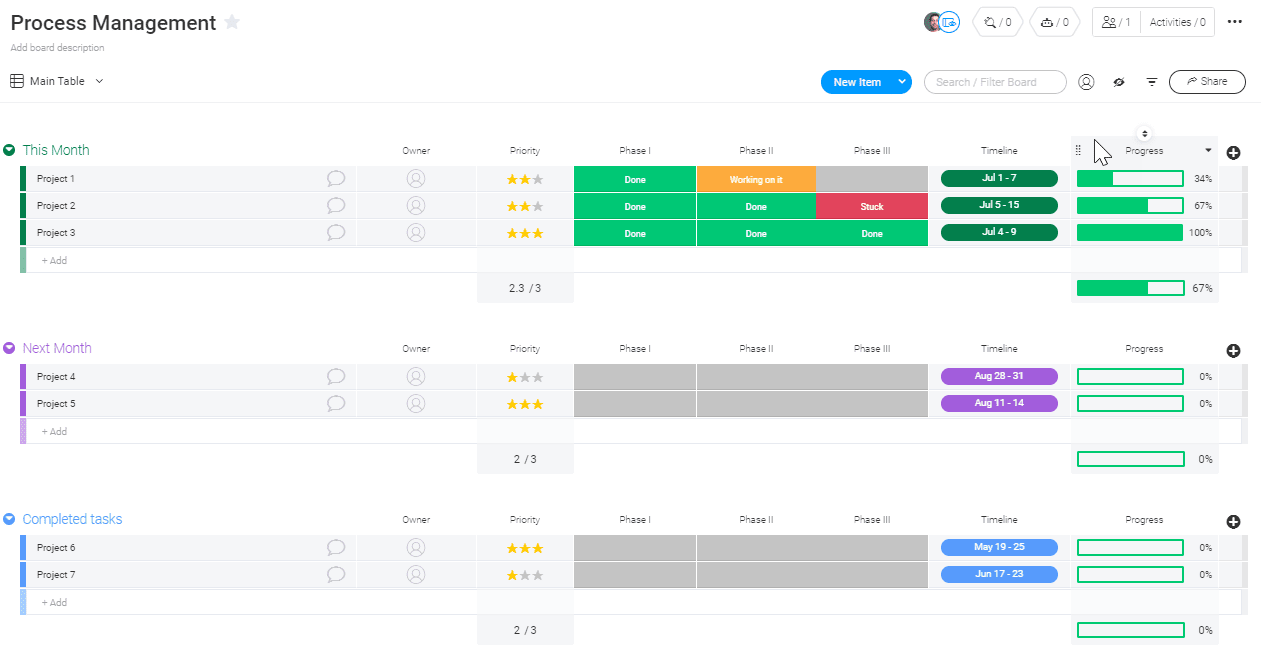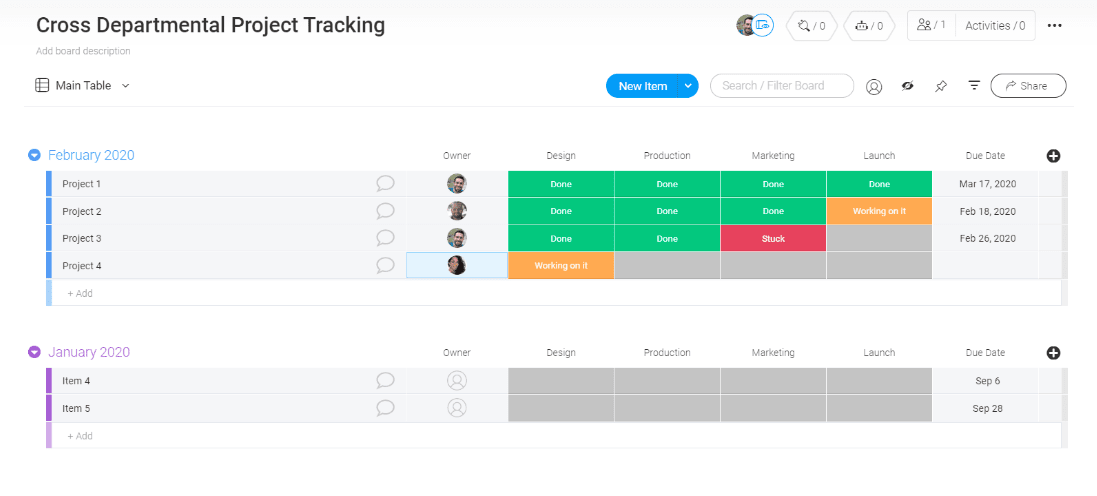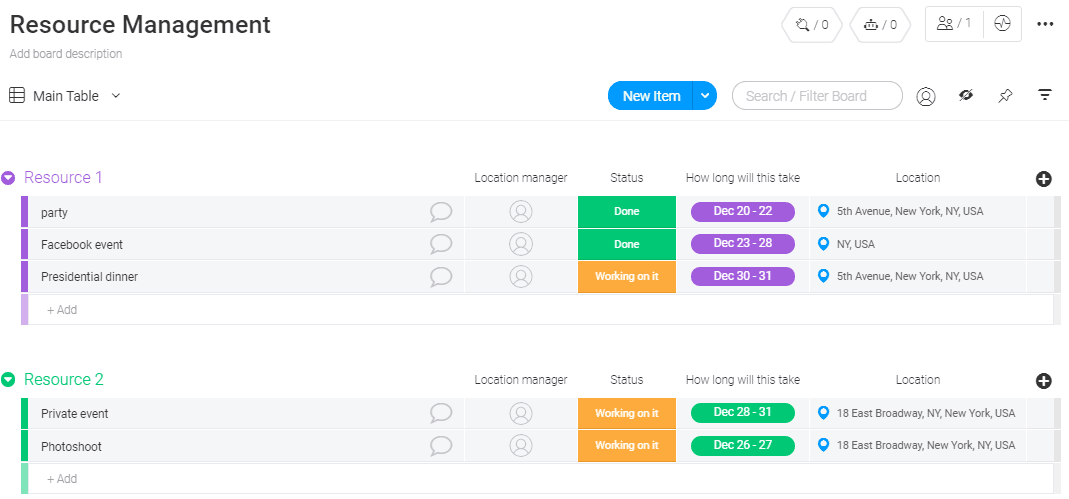With a system called integrated project management (also called project integration management or integrated project delivery), you can manage the way every facet of your project relates with every other one. Like a Zeus of the office, you can tame the thunderstorm, and ensure your project’s success by managing it holistically.
This article will tell you exactly how to set yourself up for integrated projects success and where monday.com can help.
What is integrated project management?
Integrated project management is about controlling every aspect of your project using the same processes.
Integration ensures consistency. It gets everyone working with the same processes, toward the same objectives.
Unless a business is extremely small or in an early stage, most projects will require input from multiple departments. Researchers gather information on what the customer wants. Designers build a product that meets those needs. Developers create it. Testers test it. Marketers find a way to sell it.
In integrated project management, we call each of these a process area. These people could be working in a waterfall process, or in parallel as Agile teams. The key is that, traditionally, they’re not working together. As Agile continues to take over the world, customers and clients are expecting closer communication with the companies developing products for them.
Suppose a stakeholder emails your company’s sales team, asking for a new feature. The account manager tells them you can absolutely get that done. A month goes by, and the customer hasn’t heard anything. They email the engineering manager this time…and find that he hasn’t heard anything about a new feature.
OK, that’s an extreme example, but it’s also a real risk. The company in this example failed to hold the entire project team accountable to the same processes. They failed to integrate the project.
Imagine another scenario. This time, your project manager needs to allocate a limited budget. The engineering team knows that marketing needs more money. But they don’t want their budget to get cut, so their manager claims he needs the money more. Without a central process for coordinating the project, there’s also no central goal for everyone to work towards.
The individual teams aren’t committed to something bigger than themselves.
Integrated project management averts these nightmare scenarios with 3 steps:
- First, define your process with a project charter and a project management plan.
- Then, get everyone on board by soliciting buy-in and input from all relevant stakeholders, inside the company and out.
- Lastly, use your integrated processes to make trade-offs that optimize resource allocation.
How do you integrate a project?
Let’s walk through each of the three steps in detail:
1. Define a process
The first thing you need is a project charter. This is like your project’s holy scripture. It’s a single document that lays out the most important things about your project in no more than a page — two at the most.
Or you can use monday.com’s Project Charter Template to break it down in a more visual way:

The project charter answers the 5 Ws about your project:
- What you’re going to do
- Why you’re doing it
- Who is responsible
- When project delivery will happen
- Where the benefits will be felt
A project charter is the first step toward project integration, because it gives everyone the same base. Whenever anyone is confused about the project, they can go back to the charter.
Once you’ve got your charter in hand, it’s time to answer the 6th question: how.
Develop a project plan, where you create your project’s defined process that will lead you to the goal established in the charter.
The project plan brings the lofty goals of the project charter down to Earth.
It should lay out clear actions your integrated project management company will take on a day-to-day, week-to-week timescale. You’ll probably need multiple steps running in sequence — we refer to each step as a process group.
You should also define processes that will be critical at all points throughout the project. Each of these is called a knowledge area. You absolutely can’t develop your processes after you’ve already gotten the project underway. Clear processes at the start give you the only chance of project success.
Don’t feel restricted to processes currently used by your business. Pick out the established processes that work, and leave the rest behind. And remember: everybody has to buy into your standard processes.

The monday.com process management template is a great way to shape your ideas. It’s easy to customize as you adopt new processes, and even easier to share the information with your team.
Try our process management template!
2. Get everyone on board
In step one, you made sure to create processes that none of your stakeholders could complain about. No tight time crunches for one department with leisurely strolls for another. No budget processes clearly stacked toward one side of the organization.
To fine-tune your integrated plan and make the project work, it’s time to stress-test those processes. Integrated project management absolutely requires buy-in from everyone who will have anything to do with it. You can’t, say, leave out the marketing team because they won’t have anything to do until design is finished.
It only takes one grain of sand in the gears to cause compounding problems later on. The project charter is a big help here. Using that document, you can get everyone to understand your goals on the same terms.
For this step, the most important resource isn’t money, or even coffee — it’s knowledge. If an employee is invested in the project, nothing destroys their enthusiasm faster than being left in the dark.

monday.com templates are designed to share complete, transparent information with all your stakeholders, equalizing knowledge across departments.
Our project tracking templates help keep everybody in communication. With monday.com, you can share files, automate timelines, and update everybody on the project at once.
3. Optimize your resource allocation
Integrated project management means you consider all your project’s resources as part of the same pool. Much of project management involves making decisions about moving things around, then updating those decisions as circumstances change.
Get used to thinking of resources in broader terms than just money. For example, talent is a resource. As a project manager, you’ll have a lot of talented people at your disposal. It’s your job to place them all in the roles where they’ll be the most useful. Time is a resource too. Even your best team members only have so many hours in their day.
Software can be a resource, if you’ve got a limited subscription.
So can equipment. Some projects require special machines, vehicles, or facilities.

Project management software can help ensure you always know how much you’ve got in resources, and what can be reallocated. The monday.com resource management template is a good example. Complete information lets you know where your resources are, but it also lets you measure their efficiency.
You’ll be able to tell if resources moved to one part of the project aren’t going as far as they would on another part of the project. Finally, if you need to make any changes, you can use your project management software to let everyone know immediately.
What is the best integrated project management software?
If you’ve read this far, you know that integrated project management constantly returns to one simple theme: centralize.
Centralizing integrates your project by ensuring that all information flows from, and into, the same source.
Once everyone is getting standardized information, it’s that much easier to conduct integrated change management processes that keep everybody informed of every change. Our theory at monday.com is that best integrated project management software is the platform that makes it easiest to centralize and communicate project information.
We built monday.com to be that platform. Our templates are designed so you can customize them however you like. You can pick from a list of columns to communicate exactly the information you want. Or you can design your own.
monday.com lets you keep your project team informed without any friction. Use it to build your project charter, project plan, change log, and resource management spreadsheets.Optimize integrated projects management
John Muir once said: “When we try to pick out anything by itself, we find it hitched to everything else in the universe.” Project integration management is about accepting that everything is connected.
Every aspect of your project influences all its other components. The web of relationships can get too complicated to manage without help. That’s when it’s vital to have the right software.
Look through monday.com’s selection of templates to see which one you want to get started with or jump straight into our project charter template.
Good luck taming your project thunderstorm — we’re rooting for you!

